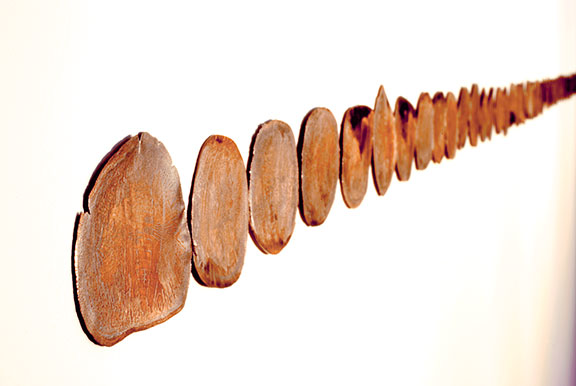By Zoe Weitzman

Photo by Daniel Bejar
Perhaps in the spirit of the conspicuously beret-ed visual artists that preceded him, Daniel Bejar wears many hats. This Brooklynite has mastered the ins and outs of the “slash” career, pursuing paths as diverse as locksmith, notorious impersonator and historically informed seamstress all under the aegis of interdisciplinary artist. But when Bejar and I spoke about his recent project, Stretchin a Dollar, his métier-of-choice was economist.
Bejar outlined the basics for me. In response to the 2008 financial crisis, he crushed 100 pennies under a freight train – Bejar’s metaphor-of-choice for weighty, forceful capitalism.
“Collectively taking one dollar out of circulation,” Bejar strove to gauge the “value of currency.” In the end, Bejar’s flattened pennies lay side-by-side on a wall extending to a full 14 feet – effectively “stretching” said dollar. Bejar goes more in depth on bailouts and birth dates below.
AIOP: Tell us a little about Stretchin a Dollar.
Bejar: Sure, Stretchin a Dollar is a project where I flattened one hundred pennies under a moving freight train. This gesture collectively removes one dollar out of circulation, and the economy. When flattened the pennies become elongated, and collectively illustrate the play on words.
AIOP: How did Stretchin a Dollar come together? What inspired you?
Bejar: Stretchin a Dollar was the second piece I made after moving to the city in 2008, which coincidentally was around the same time the economic recession was beginning. I was thinking a lot about the economy, value of currency, value of art, and my own economic reality of moving to New York and living as an artist. This piece was a response to these questions.
AIOP: The 100 pennies in Stretchin a Dollar were crushed under the wheels of a freight train. How exactly did you engineer this? I have a feeling there’s a story here.
Bejar: It’s really just like I would do as a kid, putting objects on railroad tracks, running away, then running back to see what happened, always being worried that the train would derail. Good times!
AIOP: How is Stretchin a Dollar a response to the recent economic crisis? For some of our less financially savvy readers – walk us through the implications here.
Bejar: Well, around the beginning of the crisis, we learned that the banks, which gambled with our money and lost, would be bailed out. We also learned that central banks were printing more money for these bailouts, so the value of currency was a predominant question for me around this time. For me, the piece critically looks at the value of our currency and what happens when the value of currency becomes physically destroyed under the weight of capitalism, in this instance the weight of freight trains moving products for companies. Similar to a dog biting it’s own tail.
AIOP: You’ve described the coins in Stretchin a Dollar, as objects with “birth dates” and “faces” that eventually “reach [their] demise.” Why refer to the pennies anthropomorphically?
Bejar: The reference illuminates the human aspects of pennies through the analogy of coins with birth dates stamped on them to human birth dates and a death dates. Everything has a life span.
AIOP: Considering the (awfully punny) title of this piece, what is the significance of composition and installation?
Bejar: I love puns! I wanted it to be installed horizontally on a wall in a straight line to accentuate the length and stretching of the one hundred pennies, which collectively is over 14 feet long. I also wanted it around eye level so viewers would have the opportunity to get close and view the pennies individually.
AIOP: You presented at Bushwick Basel this past June. How did viewers respond to work? How do you hope passersby will interact with Stretchin a Dollar?
Bejar: Thankfully, the response was good, but some viewers thought the pennies were flattened by one of those souvenir machines with crank levers you find at amusement parks. Hopefully the piece would draw viewers in for a closer look, and they would realize they were looking at pennies flattened by a freight train. Ultimately, I would hope the piece illuminates questions of our currency, economy, and hopefully question the value of the change we have in our pockets.
AIOP: This isn’t your first piece in which one small object unit is multiplied. Accessory For a Rear-view Forward required almost 200 mini national banners, and you adhered just about 30 house keys together for The Visual Topography of a Generation Gap. How does the proliferation, or accumulation, of a single item add layers of meaning to these pieces? Is it ever monotonous working with a single set of materials?
Bejar: I think this may come from my interest in mechanical reproduction and history. This strategy of the multiple is dependent on the project and concept. For instance, the project The Visual Topography of a Generation Gap uses multiple house keys, which make up the piece, and each key is uniquely different. Collectively, the set of keys illuminate the idea of the loss of the original. I like the philosophy of the whole being greater than the sum of its parts, and the projects you mention utilize this strategy.
The only one that was crazy monotonous was Accessory For a Rear-view Forward, the sewing together of the 200 mini national banners was no fun.
AIOP: Do you have any upcoming projects?
Bejar: Yes, I’m currently working on a project questioning with the weaponzation of nostalgia found in contemporary political campaign advertising. I’ve been collecting historical presidential campaign posters and will present them in the context of this year’s presidential campaigns and at the Republican National Convention in Tampa, FL.

